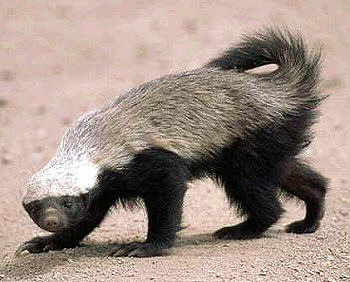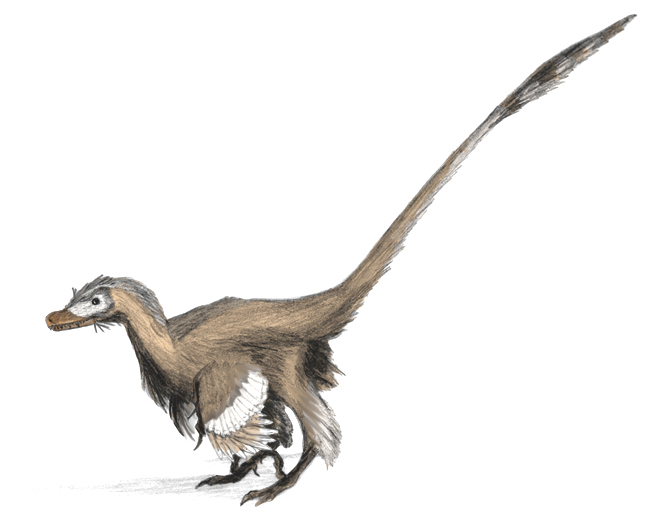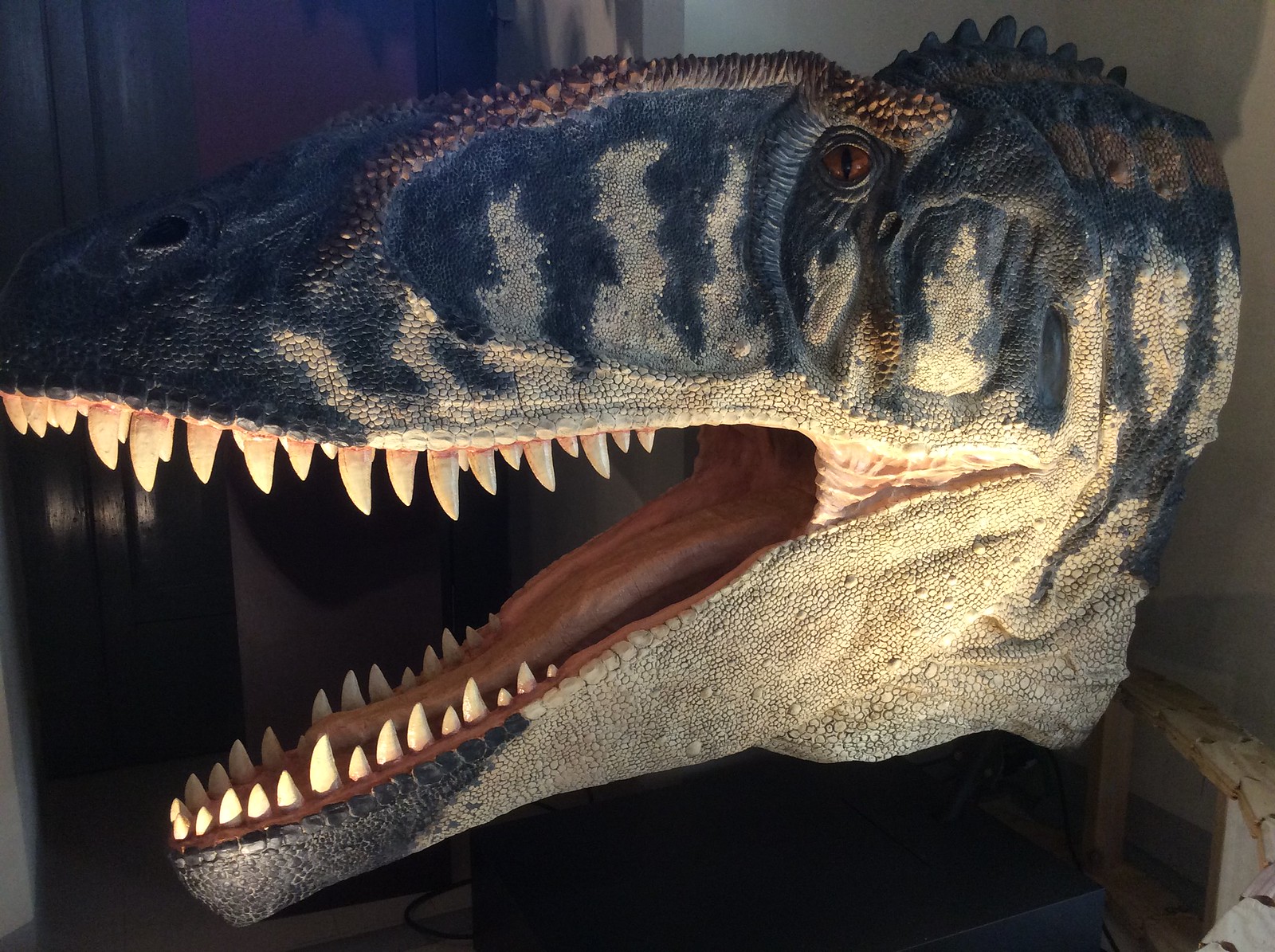Post by Infinity Blade on Jan 24, 2014 8:40:10 GMT 5
Honey Badger-Mellivora capensis
The honey badger (Mellivora capensis), also known as the ratel (/?re?t?l/ or /?r??t?l/),[3] is a species of mustelid native to Africa, Southwest Asia, and the Indian Subcontinent. Despite its name, the honey badger does not closely resemble other badger species; instead, it bears more anatomical similarities to weasels. It is classed as Least Concern by the IUCN owing to its extensive range and general environmental adaptations. It is primarily a carnivorous species and has few natural predators because of its thick skin and ferocious defensive abilities. The honey badger has a fairly long body, but is distinctly thick-set and broad across the back. Its skin is remarkably loose, and allows it to turn and twist freely within it.[12] The skin around the neck is 6 millimetres (0.24 in) thick, an adaptation to fighting conspecifics.[13] The head is small and flat, with a short muzzle. The eyes are small, and the ears are little more than ridges on the skin,[12] another possible adaptation to avoiding damage while fighting.[13] The honey badger has short and sturdy legs, with five toes on each foot. The feet are armed with very strong claws, which are short on the hind legs and remarkably long on the forelimbs. It is a partially plantigrade animal whose soles are thickly padded and naked up to the wrists. The tail is short and is covered in long hairs, save for below the base. Honey badgers are the largest terrestrial mustelids in Africa. Adults measure 23 to 28 cm (9.1 to 11 in) in shoulder height and 55–77 cm (22–30 in) in body length, with the tail adding another 12–30 cm (4.7–12 in). Females are smaller than males.[12][14] Males weigh 9 to 16 kg (20 to 35 lb) while females weigh 5 to 10 kg (11 to 22 lb) on average. Skull length is 13.9–14.5 cm (5.5–5.7 in) in males and 13 cm (5.1 in) for females.[15][16] There are two pairs of mammae.[17] The honey badger possesses an anal pouch which, unusual among mustelids, is reversible,[18] a trait shared with hyenas and mongooses. The smell of the pouch is reportedly "suffocating", and may assist in calming bees when raiding beehives.[19] The skull bears little similarity to that of the European badger, and greatly resembles a larger version of a marbled polecat skull.[20] The skull is very solidly built, with that of adults having no trace of an independent bone structure. The braincase is broader than that of dogs.

Velociraptor mongoliensis
Velociraptor (/v??l?s?ræpt?r/; meaning "swift seizer")[1] is a genus of dromaeosaurid theropod dinosaur that lived approximately 75 to 71 million years ago during the later part of the Cretaceous Period.[2] Two species are currently recognized, although others have been assigned in the past. The type species is V. mongoliensis; fossils of this species have been discovered in Mongolia. A second species, V. osmolskae, was named in 2008 for skull material from Inner Mongolia, China. Smaller than other dromaeosaurids like Deinonychus and Achillobator, Velociraptor nevertheless shared many of the same anatomical features. It was a bipedal, feathered carnivore with a long tail and an enlarged sickle-shaped claw on each hindfoot, which is thought to have been used to kill its prey. Velociraptor can be distinguished from other dromaeosaurids by its long and low skull, with an upturned snout. Velociraptor (commonly shortened to "raptor") is one of the dinosaur genera most familiar to the general public due to its prominent role in the Jurassic Park motion picture series. In the films it was shown with anatomical inaccuracies, including being much larger than it was in reality and without feathers. Some of these inaccuracies, along with the head's larger dome in the movies may suggest that the dinosaurs in the movies were actually modeled on Deinonychus.[3] Velociraptor is also well known to paleontologists, with over a dozen described fossil skeletons, the most of any dromaeosaurid. One particularly famous specimen preserves a Velociraptor locked in combat with a Protoceratops. Velociraptor was a mid-sized dromaeosaurid, with adults measuring up to 2.07 m (6.8 ft) long, 0.5 m (1.6 ft) high at the hip, and weighing up to 15 kg (33 lb).[4] The skull, which grew up to 25 cm (9.8 in) long, was uniquely up-curved, concave on the upper surface and convex on the lower. The jaws were lined with 26–28 widely spaced teeth on each side, each more strongly serrated on the back edge than the front.[1][5]
Velociraptor, like other dromaeosaurids, had a large manus ('hand') with three strongly curved claws, which were similar in construction and flexibility to the wing bones of modern birds. The second digit was the longest of the three digits present, while the first was shortest. The structure of the carpal (wrist) bones prevented pronation of the wrist and forced the 'hands' to be held with the palmar surface facing inwards (medially), not downwards.[6] The first digit of the foot, as in other theropods, was a small dewclaw. However, whereas most theropods had feet with three digits contacting the ground, dromaeosaurids like Velociraptor walked on only their third and fourth digits. The second digit, for which Velociraptor is most famous, was highly modified and held retracted off the ground. It bore a relatively large, sickle-shaped claw, typical of dromaeosaurid and troodontid dinosaurs. This enlarged claw, which could be over 6.5 cm (2.6 in) long around its outer edge, was most likely a predatory device used to tear into prey, possibly delivering a fatal blow.[7][8] As in other dromaeosaurs, Velociraptor tails had long bony projections (prezygapophyses) on the upper surfaces of the vertebrae, as well as ossified tendons underneath. The prezygapophyses began on the tenth tail (caudal) vertebra and extended forward to brace four to ten additional vertebrae, depending on position in the tail. These were once thought to fully stiffen the tail, forcing the entire tail to act as a single rod-like unit. However, at least one specimen has preserved a series of intact tail vertebrae curved sideways into an S-shape, suggesting that there was considerably more horizontal flexibility than once thought.[7][8]
In 2007, paleontologists reported the discovery of quill knobs on a well-preserved Velociraptor mongoliensis forearm from Mongolia, confirming the presence of feathers in this species.[9]

The honey badger (Mellivora capensis), also known as the ratel (/?re?t?l/ or /?r??t?l/),[3] is a species of mustelid native to Africa, Southwest Asia, and the Indian Subcontinent. Despite its name, the honey badger does not closely resemble other badger species; instead, it bears more anatomical similarities to weasels. It is classed as Least Concern by the IUCN owing to its extensive range and general environmental adaptations. It is primarily a carnivorous species and has few natural predators because of its thick skin and ferocious defensive abilities. The honey badger has a fairly long body, but is distinctly thick-set and broad across the back. Its skin is remarkably loose, and allows it to turn and twist freely within it.[12] The skin around the neck is 6 millimetres (0.24 in) thick, an adaptation to fighting conspecifics.[13] The head is small and flat, with a short muzzle. The eyes are small, and the ears are little more than ridges on the skin,[12] another possible adaptation to avoiding damage while fighting.[13] The honey badger has short and sturdy legs, with five toes on each foot. The feet are armed with very strong claws, which are short on the hind legs and remarkably long on the forelimbs. It is a partially plantigrade animal whose soles are thickly padded and naked up to the wrists. The tail is short and is covered in long hairs, save for below the base. Honey badgers are the largest terrestrial mustelids in Africa. Adults measure 23 to 28 cm (9.1 to 11 in) in shoulder height and 55–77 cm (22–30 in) in body length, with the tail adding another 12–30 cm (4.7–12 in). Females are smaller than males.[12][14] Males weigh 9 to 16 kg (20 to 35 lb) while females weigh 5 to 10 kg (11 to 22 lb) on average. Skull length is 13.9–14.5 cm (5.5–5.7 in) in males and 13 cm (5.1 in) for females.[15][16] There are two pairs of mammae.[17] The honey badger possesses an anal pouch which, unusual among mustelids, is reversible,[18] a trait shared with hyenas and mongooses. The smell of the pouch is reportedly "suffocating", and may assist in calming bees when raiding beehives.[19] The skull bears little similarity to that of the European badger, and greatly resembles a larger version of a marbled polecat skull.[20] The skull is very solidly built, with that of adults having no trace of an independent bone structure. The braincase is broader than that of dogs.

Velociraptor mongoliensis
Velociraptor (/v??l?s?ræpt?r/; meaning "swift seizer")[1] is a genus of dromaeosaurid theropod dinosaur that lived approximately 75 to 71 million years ago during the later part of the Cretaceous Period.[2] Two species are currently recognized, although others have been assigned in the past. The type species is V. mongoliensis; fossils of this species have been discovered in Mongolia. A second species, V. osmolskae, was named in 2008 for skull material from Inner Mongolia, China. Smaller than other dromaeosaurids like Deinonychus and Achillobator, Velociraptor nevertheless shared many of the same anatomical features. It was a bipedal, feathered carnivore with a long tail and an enlarged sickle-shaped claw on each hindfoot, which is thought to have been used to kill its prey. Velociraptor can be distinguished from other dromaeosaurids by its long and low skull, with an upturned snout. Velociraptor (commonly shortened to "raptor") is one of the dinosaur genera most familiar to the general public due to its prominent role in the Jurassic Park motion picture series. In the films it was shown with anatomical inaccuracies, including being much larger than it was in reality and without feathers. Some of these inaccuracies, along with the head's larger dome in the movies may suggest that the dinosaurs in the movies were actually modeled on Deinonychus.[3] Velociraptor is also well known to paleontologists, with over a dozen described fossil skeletons, the most of any dromaeosaurid. One particularly famous specimen preserves a Velociraptor locked in combat with a Protoceratops. Velociraptor was a mid-sized dromaeosaurid, with adults measuring up to 2.07 m (6.8 ft) long, 0.5 m (1.6 ft) high at the hip, and weighing up to 15 kg (33 lb).[4] The skull, which grew up to 25 cm (9.8 in) long, was uniquely up-curved, concave on the upper surface and convex on the lower. The jaws were lined with 26–28 widely spaced teeth on each side, each more strongly serrated on the back edge than the front.[1][5]
Velociraptor, like other dromaeosaurids, had a large manus ('hand') with three strongly curved claws, which were similar in construction and flexibility to the wing bones of modern birds. The second digit was the longest of the three digits present, while the first was shortest. The structure of the carpal (wrist) bones prevented pronation of the wrist and forced the 'hands' to be held with the palmar surface facing inwards (medially), not downwards.[6] The first digit of the foot, as in other theropods, was a small dewclaw. However, whereas most theropods had feet with three digits contacting the ground, dromaeosaurids like Velociraptor walked on only their third and fourth digits. The second digit, for which Velociraptor is most famous, was highly modified and held retracted off the ground. It bore a relatively large, sickle-shaped claw, typical of dromaeosaurid and troodontid dinosaurs. This enlarged claw, which could be over 6.5 cm (2.6 in) long around its outer edge, was most likely a predatory device used to tear into prey, possibly delivering a fatal blow.[7][8] As in other dromaeosaurs, Velociraptor tails had long bony projections (prezygapophyses) on the upper surfaces of the vertebrae, as well as ossified tendons underneath. The prezygapophyses began on the tenth tail (caudal) vertebra and extended forward to brace four to ten additional vertebrae, depending on position in the tail. These were once thought to fully stiffen the tail, forcing the entire tail to act as a single rod-like unit. However, at least one specimen has preserved a series of intact tail vertebrae curved sideways into an S-shape, suggesting that there was considerably more horizontal flexibility than once thought.[7][8]
In 2007, paleontologists reported the discovery of quill knobs on a well-preserved Velociraptor mongoliensis forearm from Mongolia, confirming the presence of feathers in this species.[9]














